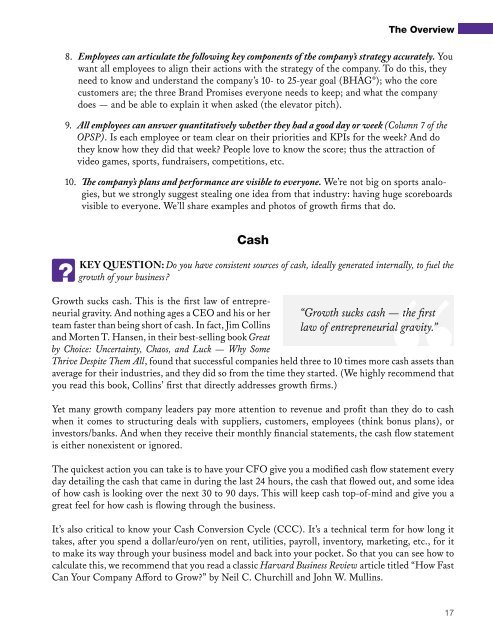Scaling-Up-Overview
You also want an ePaper? Increase the reach of your titles
YUMPU automatically turns print PDFs into web optimized ePapers that Google loves.
The <strong>Overview</strong><br />
8. Employees can articulate the following key components of the company’s strategy accurately. You<br />
want all employees to align their actions with the strategy of the company. To do this, they<br />
need to know and understand the company’s 10- to 25-year goal (BHAG ® ); who the core<br />
customers are; the three Brand Promises everyone needs to keep; and what the company<br />
does — and be able to explain it when asked (the elevator pitch).<br />
9. All employees can answer quantitatively whether they had a good day or week (Column 7 of the<br />
OPSP). Is each employee or team clear on their priorities and KPIs for the week? And do<br />
they know how they did that week? People love to know the score; thus the attraction of<br />
video games, sports, fundraisers, competitions, etc.<br />
10. The company’s plans and performance are visible to everyone. We’re not big on sports analogies,<br />
but we strongly suggest stealing one idea from that industry: having huge scoreboards<br />
visible to everyone. We’ll share examples and photos of growth firms that do.<br />
Cash<br />
KEY QUESTION: Do you have consistent sources of cash, ideally generated internally, to fuel the<br />
growth of your business?<br />
Growth sucks cash. This is the first law of entrepreneurial<br />
gravity. And nothing ages a CEO and his or her<br />
team faster than being short of cash. In fact, Jim Collins<br />
and Morten T. Hansen, in their best-selling book Great<br />
by Choice: Uncertainty, Chaos, and Luck — Why Some<br />
“Growth sucks cash — the first<br />
law of entrepreneurial gravity.”<br />
Thrive Despite Them All, found that successful companies held three to 10 times more cash assets than<br />
average for their industries, and they did so from the time they started. (We highly recommend that<br />
you read this book, Collins’ first that directly addresses growth firms.)<br />
Yet many growth company leaders pay more attention to revenue and profit than they do to cash<br />
when it comes to structuring deals with suppliers, customers, employees (think bonus plans), or<br />
investors/banks. And when they receive their monthly financial statements, the cash flow statement<br />
is either nonexistent or ignored.<br />
The quickest action you can take is to have your CFO give you a modified cash flow statement every<br />
day detailing the cash that came in during the last 24 hours, the cash that flowed out, and some idea<br />
of how cash is looking over the next 30 to 90 days. This will keep cash top-of-mind and give you a<br />
great feel for how cash is flowing through the business.<br />
It’s also critical to know your Cash Conversion Cycle (CCC). It’s a technical term for how long it<br />
takes, after you spend a dollar/euro/yen on rent, utilities, payroll, inventory, marketing, etc., for it<br />
to make its way through your business model and back into your pocket. So that you can see how to<br />
calculate this, we recommend that you read a classic Harvard Business Review article titled “How Fast<br />
Can Your Company Afford to Grow?” by Neil C. Churchill and John W. Mullins.<br />
17



